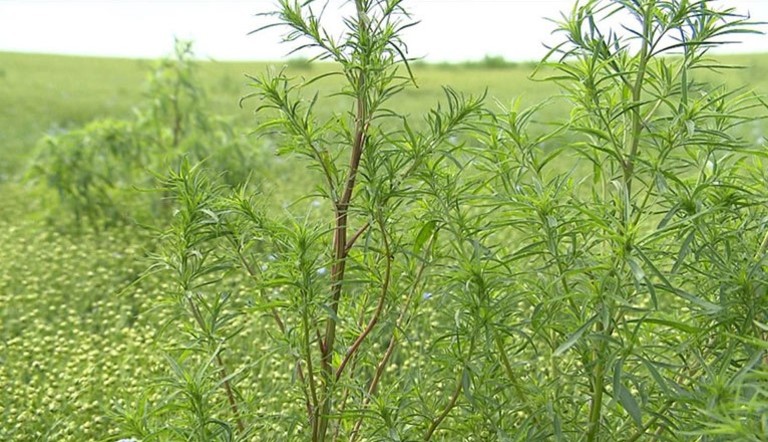
Pest Profile: Kochia

IDENTIFICATION
The earliest emerging leaves of the kochia seedling develop in the springtime and are elongated, slightly club shaped and covered in soft hairs. When mature, the reddish stem is covered with fine white hairs with many branches growing out resulting in large conical-shaped bushes. Clusters of small green flowers appear along the branches and turn brownish-yellow when they begin to seed. The seeds have yellow markings and have grooves on each side.
KOCHIA RESISTANCE OVERVIEW
Genetic Variability: Kochia can cross and self-pollinate which results in wide genetic diversity, including mutations linked to herbicide resistance.
PLANT GROWTH
Competitive Environments: Erect, single-stemmed.
Open Environment: Bushy, multibranched.
Leaf Structure: Early growth (button stage) has fine, dense white hairs that inhibit herbicide penetration by suspending droplets above the leaf cuticle. After the button stage, as leaves grow the hair density decreases and plants will have smoother tops with hairy undersides. Kochia becomes more difficult to control as it matures, and products become less effective when the plant reaches heights of 10-15 cm or more.
ENVIRONMENTAL ADAPTABILITY
Highly adaptable to diverse conditions, including saline and drought-prone areas. Kochia responds to fertility and tends to be larger and produces more seeds in cultivated fields.
REPRODUCTIVE BIOLOGY
Protogynous flowering: Female parts are receptive before male parts develop, promoting outcrossing. Many resistance traits are genetically transferable.
CONFIRMED HERBICIDE RESISTANCE
Group 2 (ALS Inhibitors): First confirmed in 1988 (MB & SK).
Group 4 (Auxin Mimics): First confirmed in 2015 (SK).
Group 9 (Glyphosate/EPSPS Inhibitors): First confirmed in 2011 (AB); 87% of tested plants in Saskatchewan were resistant by 2019.
Group 14 (PPO Inhibitors): First confirmed in 2021 (SK)
TRENDS
- Most Kochia plants show resistance to Group 2 and many to Group 9.
- Many plants have stacked resistance to multiple groups, severely limiting herbicide options.
INTEGRATED PEST MANAGEMENT
A proactive approach is crucial in effective Kochia management:
- Diverse crop rotations and increased crop competition/density.
- Mitigate saline areas.
- Pre seed strategies are effective.
- In crop: aim to spray early. Kochia emergences early and grows quickly, and is easier to control when small.
- Always mix and rotate herbicides – Read product labels for recommended tank mix partner, rate, and timing.
- Early spring tillage and mowing plants can both be effective management tools.
- Prevent kochia plants from setting seed.
- Higher water volumes are most effective in reaching the plant cuticle through its dense hairs.
CONTROL TIPS
- Because kochia germinates early, pre-seed burnoff can be an effective management strategy.
- Use an effective mix of active ingredients that work on the kochia present in the field.
- Spraying kochia at 4 inches (10cm) or less will offer the best opportunity for control.
- Scout after spraying. If kochia plants survived pre-seed burnoff and the first spray, a second herbicide application may help if weeds are still at the appropriate stage.
- If second application is not effective or if kochia plants are too large, physical removal may be required. Options include mowing or hand weeding.
- Test for herbicide resistance.
REGISTERED HERBICIDES
| Application (crop) | Product | Active Ingredients | Group | Comments |
|---|---|---|---|---|
| Pre Seed (Cereal & Canola) | EMPHASIS® & Glyphosate | Carfentrazone, bromoxynil & glyphosate | 6 & 14 | Option for Glyphosate group 9 and ALS group 2 resistant biotypes |
| EMPHASIS® MAX & Glyphosate | Carfentrazone, bromoxynil & glyphosate | 6 & 14 | Option for Glyphosate group 9 and ALS group 2 resistant biotypes | |
| GORDEX™ & Glyphosate | Dicamba 480 SL & Florasulam | 2 & 4 | Option for Glyphosate group 9 and ALS group 2 resistant biotypes | |
| INVOLVE® 50 WDG & Glyphosate | Tribenuron-methyl & Glyphosate | 2 & 9 | ||
| Cereals | 2, 4-D Ester 700 | 2, 4-D Ester | 4 | |
| BADGE® | Bromoxynil & MCPA ester | 4 & 6 | Spray before plants are two inches high. | |
| BROMOTRIL® 240 EC | Bromoxynil octanoate ester | 6 | Spray before plants are two inches high. | |
| ESTEEM ALL IN® | Fluroxypyr & clopyralid | 4 | ||
| FORCEFIGHTER ALL IN® | Fluroxypyr, bromoxynil, and MCPA | 4 & 6 | Option for Glyphosate group 9 and ALS group 2 resistant biotypes. | |
| OUTSHINE ALL IN® | Florasulam, fluroxypyr, & MCPA Ester | 2 & 4 | Option for ALS resistant biotypes. | |
| MCPA ESTER 600 | MCPA Ester | 4 | 2-4 leaf rapidly growing, good growing conditions. | |
| RUSH 24 ALL IN® | Fluroxypyr & 2, 4-D ester | 4 | Including ALS resistant biotypes. | |
| Pulses | SQUADRON® | Metribuzin | Group 5 | |
| Canola | ADAMA GLUFOSINATE 150 SL | Glufosinate | Group 10 |
Please read each label to determine which herbicide is appropriate for the crop affected.
References and Additional Reading
“How to Contain Herbicide Resistant Kochia”” Canola Council of Canada. Online.
https://www.canolacouncil.org/canola-watch/fundamentals/how-to-contain-herbicide-resistant-kochia/
“Watch for Suspicious Weed Patches(Kochia Angle)”” Canola Council of Canada. Online
https://www.canolacouncil.org/canola-watch/2018/06/27/watch-for-suspicious-weed-patches-kochia-angle/
“Kochia” Government of Ontario. Online
https://www.ontario.ca/document/weed-identification-guide-ontario-crops/kochia#:~:text=Kochia%20has%20bladder%2Dlike%20seed,Taproot%20with%20branched%20fibrous%20roots
Canola Council of Canada (2024). How to contain herbicide-resistant kochia. Retrieved from https://www.canolacouncil.org/canola-watch/fundamentals/how-to-contain-herbicide-resistant-kochia.
Colorado State University. (n.d.). Kochia. Colorado State University Agricultural Biology. Retrieved from https://agsci.colostate.edu/agbio/ipm-pests/kochia
Government of Manitoba. (n.d.). Managing Kochia. Retrieved from https://www.gov.mb.ca/agriculture/crops/weeds/print,managing-kochia.html#:~:text=Kochia%20seed%20production%20ranges%20from,way%20of%20spreading%20its%20seeds
Manage Resistance Now (2024). Managing herbicide-resistant kochia. Retrieved from https://manageresistancenow.ca/weeds/managing-herbicide-resistant-kochia
[RealAgriculture]. (2024, May 1). Wheat School: Why kochia is so hard to kill and so prone to herbicide resistance [Video]. YouTube. https://www.youtube.com/watch?v=TDBq6Mtd_ec
Washington State Noxious Weed Control Board. (n.d.). Kochia. Retrieved from https://www.nwcb.wa.gov/weeds/kochia